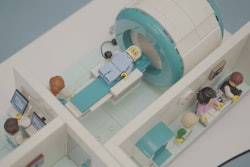
TORONTO - Play therapy improves children's MRI exam experience and makes it possible for them to remain awake during imaging, according to research presented at the International Society for Magnetic Resonance in Medicine (ISMRM) meeting in Toronto, Canada.
The results were shared June 4 by MRI radiographer Charlotte Swain of the U.K.'s Nottingham University Hospitals NHS Trust as part of a poster session for the International Society of MRI Radiographers (ISMRT) gathering.
"With fun and engaging play methods, [we found it] possible to acquire diagnostic images in 98% of children scanned," she and colleagues noted. "With no risk when compared to a general anesthetic and a more relaxed atmosphere and process, this has vastly improved the patient experience, for not only the children, but also their parents/carers."
The frequency of pediatric MRI exams has increased, and this patient population can be challenging to image, the team explained. Children often require general anesthesia for MR imaging -- which carries additional physical risks and healthcare costs. But play therapy has been shown to help children undergo MRI exams without general anesthetic.
At Nottingham University Hospitals, a "play specialist" protocol is used once a week to scan children between the ages of three and 13. As part of this approach, the specialist explains the exam process, highlighting the need for the child to lie down and to remain still and noting the exam time and that the scan may be noisy. The MRI exam waiting area is decorated with child-friendly murals and features a miniature "Kitten scanner" children can use to scan stuffed animals. Throughout the exam, children can watch a movie and/or listen to audio selections through headphones.
The investigators secured funding for a full-time play specialist for 12 months. They initially conducted a pilot study that included eight children; seven of these completed the exam with diagnostic images, while one had to return to complete the exam under anesthesia due to noise sensitivity. After this pilot effort, the team began to use the play therapy approach for six to eight children per week, with most of the children undergoing MR imaging without contrast.
Eventually, the team conducted a study that included 181 children, adjusting scanning protocols to minimize the number of sequences and prioritize less noisy studies. Of these 181, 10 returned for MR imaging with anesthesia, and three did not attend their appointment. Most of the patients were between 3 and 13, although there was one 2-year-old child and a 20-month-old child.
The investigators found that, overall, 98% of the MR exams were diagnostic. They also found the following:
- Only 2% of the exams were undiagnostic.
- 5% were "heavily degraded" but still diagnostic.
- 4% were moderately diagnostic.
- 17% were mildly diagnostic.
- 72% had no noteworthy motion artifact showing the success of this new pathway.
Challenges to the protocol included limited scanner capacity, a lack of available play specialists, and delays due to complicated tube insertions or waiting for clinicians to administer contrast, the team noted.
This play therapy approach to pediatric MR imaging offers solid benefits, according to Swain's team.
"Play therapy has been an excellent addition to the options available for pediatric patients needing an MRI scan," the group concluded. "Not only is it safer for the child ... it is more pleasant and less stressful for the parents."




.fFmgij6Hin.png?auto=compress%2Cformat&fit=crop&h=100&q=70&w=100)




.fFmgij6Hin.png?auto=compress%2Cformat&fit=crop&h=167&q=70&w=250)











